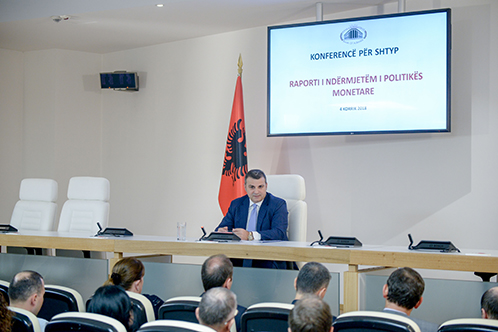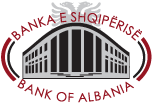BANK OF ALBANIA
PRESS RELEASE
Governor Sejko: Statement to the Press Conference on the Monetary Policy Decision of the Supervisory Council of the Bank of Albania
Publication date: 04.07.2018
The new information analysed in this Intermediate Report suggests that the Albanian economy continues on a positive development trend. In particular, economic growth in the first quarter was higher than our expectations, while inflation was slightly up in April and May, compared with the first quarter. Financial markets are characterised by low interest rates and improving liquidity indicators, but the exchange rates continue to appear strong and credit growth remains sluggish.

The updated forecasts did not bring about considerable changes in the expected trajectories of future developments. The baseline scenario suggests that the Albanian economy will continue to grow, driving the build-up of domestic inflationary pressures. The appreciated exchange rate will tend to decelerate inflation over the next quarters, but the effect of this factor is expected to be transitional. Therefore, inflation is expected to steadily return to its target within 2020.
In these circumstances, the Supervisory Council deems that the current monetary policy stance, in its historical low of 1% of the policy rate and in the temporary program of interventions in the domestic foreign exchange market, remains adequate.
Let me explain in greater detail.
Annual inflation was 2.1% in April and May, against the average rate of 1.9% in the previous quarter.
From the perspective of the basket composition, inflation ticked up as result of the increase in the prices of non-food items and of housing services. From the macroeconomic perspective, the increase in production costs and imported inflation continue to affect inflation at the same degree. Nevertheless, our analyses show that both components have already been affected by the exchange rate appreciation.
According to INSTAT data, the Albanian economy grew 4.45% in 2018 Q1. Indirect available data point to positive growth rates for the second quarter as well. From the sectorial perspective, the economic activity expansion was mainly driven by the growth in the industry sector, and in particular by the growth in production and export of electricity. From the perspective of aggregate demand, growth was driven by the expansion in private consumption, aggregate investments and the export of goods and services. The growth in imports hindered economic growth.
The expansion of the aggregate demand has led to a better utilisation of production capacities, particularly in the labour market. The unemployment rate fell to 12.5% and the average wage increased by 2.3% in annual terms. These developments suggest that the cyclical improvement of the Albanian economy has started to materialize in the increase of the domestic inflationary pressures.
Economic growth continues to be driven by a stimulating monetary and financial environment, the increase of employment and improved confidence and the upswing in the external demand.
In response to the accommodative monetary policy of the Bank of Albania and fiscal consolidation, the interest rates in financial markets remain low and the liquidity situation is improving. The average interest rate on lek loans fell at 6.3% in May, supporting the reduction of borrowing costs and stimulating the annual growth by 6.6% of credit in lek. On the other hand, total credit to private sector recorded 4.9% annual growth rate in April and May, corrected for the exchange rate effect and the loan write offs.
Credit performance is affected by both low credit demand and the still tight lending policies implemented by the banking sector. Regarding the latter, the Bank of Albania deems that banks’ balance sheets are growing sound, as shown by the fall of non-performing loans ratio at 13.3% in May 2018. In addition, credit risk in Albania continues to fall, attributable to the cyclical improvement of the economy and the measures for the resolution of the non-performing loans. Under these circumstances, the banking sector should be more pro-active and attentive in meeting the medium and long-term financing needs of the economy.
Finally, financial markets were characterised by relatively strong unbalances in the demand and supply for foreign currency, which drove to the rapid appreciation of the exchange rate. In our view, this disequilibrium was generated by temporary factors in the foreign exchange market. Nevertheless, the resulting exchange rate appreciation was assessed as harmful from the perspective of achieving the inflation target and triggered the intervention of the Bank of Albania to address it.
The intervention in the market, approved on 6 June and implemented in the next days, has already provided positive effects, by decelerating the strong appreciation trend of the exchange rate and providing a more calm and normal foreign exchange activity in the market.
Our expectations for the future remain positive.
Based on the current development trends and their underlying factors, the Bank of Albania expects further growth of economic activity and a better utilisation of production capacities in the medium-term horizon. These developments will contribute to a faster increase in wages and production costs, enabling the return of inflation to target within 2020.
The current monetary policy stance is an important supporting factor to these developments. The low policy rate guarantees low financing costs, whereas the program of intervention in the domestic foreign exchange market helps calm down the activity in the domestic foreign exchange market and prevents the exchange rate appreciation.
[Judging on the above, the Supervisory Council decided to:
- Keep the policy rate unchanged, at 1.0%;
- Keep the overnight deposit and overnight lending rates, unchanged at 0.1% and 1.9%, respectively.
In line with our forecasts for the outlook and the risk balance surrounding them, the Supervisory Council judges that the return of the policy rate into an upward trajectory will not begin before 2019 Q2.
Also, the Supervisory Council considered as necessary to continue the intervention program in the domestic foreign exchange market. In this regard, the Supervisory Council reiterates that the foreign currency purchasing program is an extraordinary and temporary instrument of the monetary policy. The program is exclusively aimed at complying with the price stability objective and is dictated by the environment with low interest rates. As such, its duration will be only limited, conditioned by the prevention of the negative impact of the exchange rate on the achievement of the inflation target.

 Twitter
Twitter
 Youtube
Youtube
 Facebook
Facebook
 Flickr
Flickr
 RSS
RSS
 Subscribe
Subscribe
 Feedback
Feedback